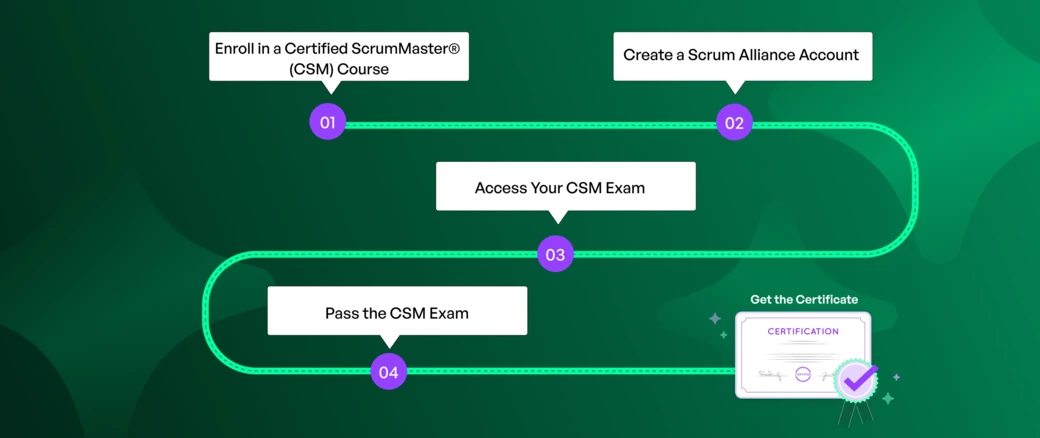Who Is a Scrum Master?
A Scrum Master holds a vital position within the Scrum framework, acting as the servant leader and facilitator for Agile teams. Their primary responsibility is to ensure that Scrum practices are understood and properly implemented by the team. As a guide and coach, the Scrum Master supports team members by removing obstacles towards progress and promoting a collaborative environment that fosters continuous improvement. They work closely with the Product Owner and stakeholders to help the team deliver timely, high-quality results. By encouraging Agile values and principles, Scrum Masters are key in enhancing team effectiveness and driving successful project delivery across the organisation.
Certified Scrum Master Career Path
The Scrum master certification path offers a variety of growth opportunities as you gain experience and skills. The career path for Scrum Master professionals begins with core facilitation skills and grows into strategic leadership positions, offering diverse options beyond just Agile coaching.
From the foundational Scrum Master role, professionals can progress into leadership, coaching, and strategic positions within Agile environments. Each step along the career path after scrum master involves new responsibilities and opportunities to influence team and organisational success.
1. Scrum Master
This is the entry-level role where you learn to facilitate Scrum ceremonies, remove impediments, and support the development team in following Agile practices. It’s the foundational step in the scrum master career progression.
2. Senior Scrum Master
With more experience, you can move to a Senior Scrum Master role, taking on larger or multiple Scrum teams. Here, you mentor junior Scrum Masters and help resolve more complex challenges within Agile projects.
3. Scrum Master Manager
As a Scrum Master Manager, you oversee a group of Scrum Masters, ensuring best practices are consistently applied across teams. This role includes coaching Scrum Masters and collaborating with senior leadership.
4. Mentor
Mentors guide less experienced Scrum Masters and Agile practitioners by sharing knowledge, best practices, and providing career advice. This role often overlaps with coaching but focuses on personal development.
5. Product Owner
Transitioning to a Product Owner role is common for Scrum Masters who want to focus more on product strategy and backlog management. It’s a crucial role that bridges business needs with development teams.
6. Agile Coach
Agile Coaches work at an organisational level, helping multiple teams and departments adopt Agile practices. They guide transformations and foster a culture of continuous improvement.
7. Project Manager
Experienced Scrum Masters can also move into Project Management roles, leveraging their Agile knowledge to oversee broader project planning, risk management, and stakeholder communication.
8. Chief Information Officer (CIO)
At the senior-most level, Scrum Masters with strategic vision and leadership skills can rise to executive positions such as CIO, shaping the technological and Agile direction of the entire organisation.
Why Choose a Career in Scrum Master?
The Scrum master certification path is becoming increasingly popular as Agile adoption grows. In 2025, the demand for skilled Scrum Masters is expected to rise by over 20%, making it a promising and future-proof profession.
Here are the top reasons why choosing a career as a Scrum Master is a smart move:
High demand across industries towards the adoption of Agile frameworks.
Opportunities for continuous learning and professional growth.
Competitive salaries and attractive benefits.
Ability to work closely with diverse teams and stakeholders.
A clear and versatile scrum master career roadmap for progression.
With structured certifications and demand-driven growth, the career path for Scrum Master roles is one of the most rewarding in today’s job market.
How to Start Your Career in Scrum Master?
Here’s a detailed step-by-step guide to kickstart your CSM career journey:
Step1: Scrum Master Certification Path
Enrol in the CSM Course
Join the Certified Scrum Master (CSM) course offered by StarAgile, accredited by Scrum Alliance, the official certifying body for CSM globally.Attend the CSM Training
Complete the 2-day online training delivered by Certified Scrum Trainers (CSTs). StarAgile’s course includes case studies, simulations, and real-time Agile scenarios to make learning interactive.Take the CSM Exam
After training, you’ll receive a unique exam link from Scrum Alliance. Use it to take the online test at your convenience.Prepare and Practice
Revise key Scrum concepts using the StarAgile training material, mock tests, and Scrum guides to ensure you’re ready.Clear the CSM Exam
The CSM exam consists of 50 multiple-choice questions, and you need to get at least 37 correct answers (74%) to pass.Get Your CSM Certification
Once you pass the exam, you’ll receive the official CSM certificate from Scrum Alliance, valid for 2 years, with an option to renew.
Completing the CSM certification sets you up for success in Agile environments and unlocks diverse career opportunities in project leadership, team facilitation, and enterprise agility. and also know about the daily scrum.
Step 2: How to Get into the Role of a Scrum Master After CSM Certification?
After earning your CSM certification, the next step is to enter the Scrum Master role with the right strategy.
1. Adopt the Agile Mindset
Start thinking like a Scrum Master—focus on collaboration, adaptability, and servant leadership.
2. Update Your Profile
Revamp your resume and LinkedIn to highlight your CSM credential, Agile knowledge, and hands-on training or projects.
4. Apply for Entry-Level Roles
Look for roles like Junior Scrum Master or Agile Coordinator to build experience and grow gradually.
5. Be Interview Ready
Prepare for common Scrum scenarios, Agile practices, and behavioural questions to ace interviews.
6. Keep Learning
To enhance your profile, pursue advanced certifications such as PSM and A-CSM, and explore related frameworks. This will assist you in transitioning to advanced Scrum Master roles.
Conclusion
In today’s fast-paced Agile-driven world, the role of a Scrum Master has evolved into a critical leadership position. With organisations increasingly relying on Scrum practices to deliver value faster and more efficiently, the demand for certified Scrum Masters continues to grow. Whether you’re just starting or looking to advance your career, becoming a Certified Scrum Master (CSM) offers a structured path, global recognition, and a wide range of opportunities in Agile project management. With the right training, mindset, and commitment, you can confidently step into this rewarding and future-proof career path. For those seeking long-term growth, the career path for Scrum Master professionals provides stability, relevance, and diverse advancement options.
FAQ’s
1. What skills are needed to become a successful Scrum Master?
Strong communication, leadership, problem-solving, facilitation, and a deep understanding of the Scrum framework are essential skills in the career path of Scrum master.
2. What are the benefits of being a Scrum Master?
The benefits of being a Scrum Master include high demand, a competitive salary, leadership opportunities, job satisfaction, and the chance to drive real change in teams.
3. Can someone with a non-technical background become a Scrum Master?
Yes, Scrum focuses on team facilitation and Agile practices—technical skills are helpful but not mandatory.
4. Is Scrum Master a growing career?
Absolutely scrum master is a good career option. As Agile adoption grows globally, the need for skilled Scrum Masters is consistently increasing.
5. How do I become a Scrum Master with no experience?
To become scrum master, follow the career path for a Scrum Master, begin by enrolling in a Certified Scrum Master (CSM) course to acquire foundational knowledge, earn your certification, and apply it in small projects or volunteer opportunities.
6. What are the career paths after Scrum Master?
Career paths include Senior Scrum Master, Agile Coach, Product Owner, Project Manager, and leadership roles like CIO or Program Manager.







 In 2025, the demand for certified Scrum Masters surges as Agile practices become central to business agility and product success.
In 2025, the demand for certified Scrum Masters surges as Agile practices become central to business agility and product success. 






